Best Document Automation Software for 2025
Revolutionize Your Document Processes with These Automation Tools
Creating and managing documents takes valuable time. This listicle presents 10 document automation software solutions to streamline your workflows. Whether you're a legal professional, healthcare provider, or compliance officer, these tools help eliminate tedious tasks, reduce errors, and improve efficiency. Explore the top 10 tools of 2025, including Whisperit, DocuSign, PandaDoc, and more, to find the perfect solution for your needs.
1. Whisperit
Whisperit is a powerful AI-driven dictation and document automation platform designed to significantly boost productivity for professionals in document-heavy fields like law, healthcare, and compliance. It leverages advanced voice recognition and AI to streamline document creation, editing, and management, allowing users to draft and edit documents up to twice as fast. This translates to significant time savings, freeing up professionals to focus on higher-value tasks and ultimately contributing to substantial cost reductions. Beyond simple dictation, Whisperit offers intelligent features like case file analysis and legal research, further enhancing its value proposition for specific professional applications.
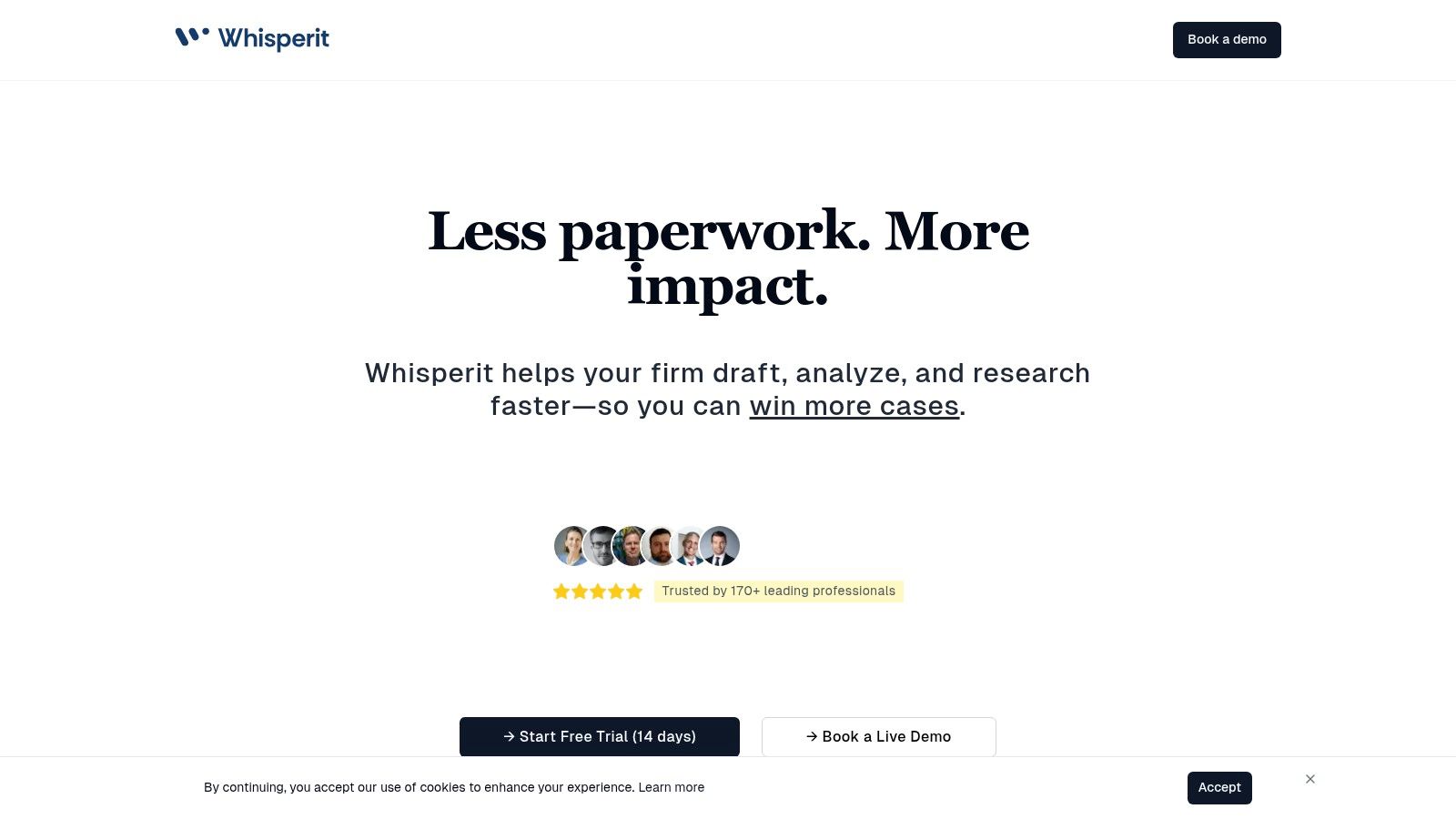
Use Cases and Practical Applications:
- Legal Professionals: Dictate legal briefs, contracts, and other documents on the go or in the office. Leverage the AI-powered legal research and case file analysis capabilities to quickly gather information and build stronger arguments. Customizable templates and smart formatting ensure consistent branding and adherence to legal standards.
- Healthcare Providers: Streamline medical report creation, patient note documentation, and other administrative tasks through voice dictation. This reduces administrative burden and allows for more time dedicated to patient care.
- Compliance Officers: Efficiently create and manage compliance reports, policy documents, and audit trails. Whisperit's robust security features ensure sensitive information remains protected.
Features and Benefits:
- AI-Powered Dictation and Editing: Highly accurate voice recognition with advanced editing capabilities.
- Intelligent Case File Analysis and Legal Research: Streamlines information gathering for legal professionals.
- Customizable Templates and Smart Formatting: Ensures consistent branding and document structure. Import existing documents and templates to maintain workflow continuity.
- Security and Compliance: Swiss hosting, encryption, GDPR, and SOC 2 compliance guarantee data security and privacy.
- Cost Savings: Potential annual savings of up to $660,000 for firms, according to Whisperit.
Pros:
- Significantly reduces document creation time.
- Ensures top-notch security and compliance.
- Offers specialized features for legal and compliance professionals.
- Customizable templates and import features enhance workflow integration.
- Backed by testimonials from industry experts.
Cons:
- Primarily tailored for professional and document-intensive fields, which may limit its appeal for casual users.
- Advanced features may require a learning curve for full integration into existing workflows.
- Pricing information is not readily available on the website.
Implementation and Setup Tips:
While specific technical requirements are not detailed on the website, it's likely Whisperit offers both cloud-based access and potentially desktop applications. Users should anticipate an initial setup process to customize templates, integrate with existing systems (if applicable), and familiarize themselves with the software's features. Whisperit's website mentions training resources and customer support, which can be valuable during implementation.
Comparison with Similar Tools:
While other dictation software exists, Whisperit differentiates itself through its focus on professional applications, particularly in the legal field. Its integrated legal research and case analysis features, combined with robust security and compliance measures, position it as a more specialized solution compared to general dictation tools.
Website: https://whisperit.ai
Why Whisperit Deserves Its Place on This List:
Whisperit earns its spot due to its targeted approach to document automation for specific professional needs. Its combination of advanced AI dictation, specialized features for legal and compliance professionals, and robust security measures makes it a compelling solution for organizations seeking to drastically improve efficiency and reduce costs associated with document creation and management. While a steeper learning curve and potentially higher price point may exist compared to basic dictation software, the significant productivity gains and specialized features justify its inclusion for the target audience.
2. DocuSign
DocuSign is a leading document automation platform renowned for its robust electronic signature capabilities and comprehensive workflow management. It empowers businesses of all sizes to streamline agreement processes, from preparation and signing to action and secure storage. This makes it an ideal solution for legal professionals, healthcare providers, and security/compliance officers who require secure, efficient, and legally sound document handling. Its wide adoption and integration with over 350 applications, including staples like Microsoft Office 365, Google Workspace, and Salesforce, make it a versatile tool that fits seamlessly into existing workflows. Its focus on security and compliance, evident in its SOC 2, GDPR, and ISO 27001 certifications, positions it as a trustworthy choice for handling sensitive information.
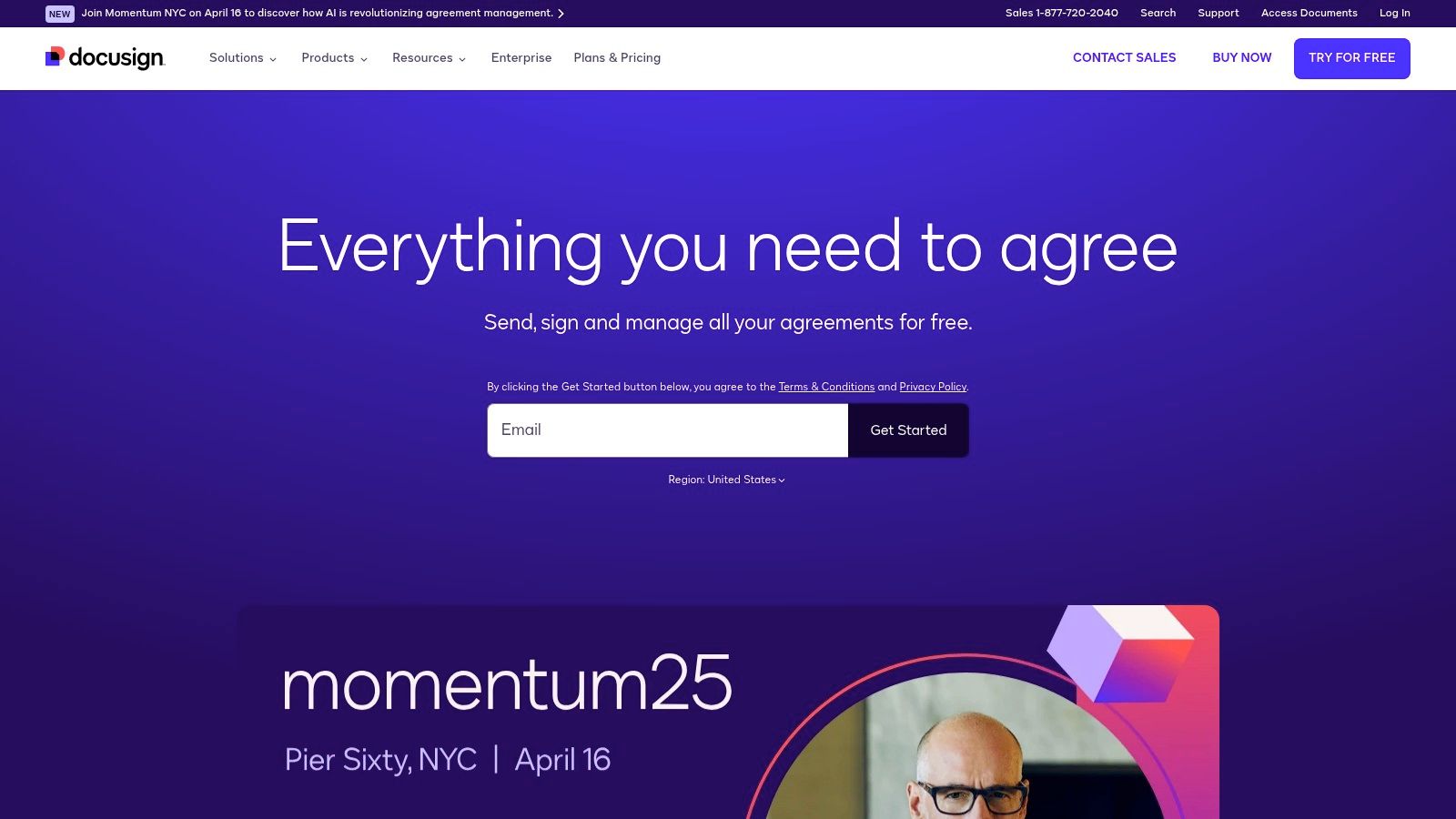
For legal professionals, DocuSign facilitates faster contract execution, reduces the risk of errors, and improves client experience by eliminating the need for physical paperwork. Healthcare providers can use it to manage patient consent forms, medical records releases, and other critical documents securely and efficiently, ensuring HIPAA compliance. Security and compliance officers benefit from the platform's robust audit trails, which provide a comprehensive record of every document interaction, simplifying compliance audits and investigations.
Features and Benefits:
- Electronic Signature Collection and Management: Securely collect legally binding electronic signatures from anywhere in the world, accelerating agreement turnaround times.
- Template Creation and Document Generation: Create reusable templates for frequently used documents, reducing manual data entry and ensuring consistency.
- Advanced Workflow Automation with Conditional Routing: Automate complex document workflows with rules-based routing, ensuring documents reach the right people at the right time. This is particularly valuable for approvals and multi-party agreements.
- Real-Time Tracking and Audit Trails: Monitor document progress in real time and access detailed audit trails for every action taken, enhancing transparency and accountability.
- Mobile-Friendly Interface with Offline Capabilities: Access and manage documents from any device, even without an internet connection, ensuring business continuity.
Pros:
- Intuitive User Interface: Minimal training is required to get started, enabling rapid adoption across teams.
- Robust Security and Compliance: SOC 2, GDPR, and ISO 27001 compliance provide assurance for handling sensitive information.
- Extensive Integration Ecosystem: Seamlessly integrates with hundreds of business applications, streamlining workflows.
- Strong Mobile Experience: Facilitates on-the-go document management, increasing efficiency and flexibility.
Cons:
- Higher Pricing: Compared to some competitors, DocuSign's higher-tier plans can be expensive, particularly for smaller businesses.
- Advanced Features Limited to Higher Tiers: Some advanced features, like conditional routing and advanced reporting, are restricted to more expensive plans.
- Initial Template Setup: Creating and configuring templates can be time-consuming initially, requiring careful planning and attention to detail.
Pricing: DocuSign offers various pricing tiers based on features and user requirements. Details are available on their website.
Technical Requirements: DocuSign is a cloud-based solution accessible through a web browser. Mobile apps are available for iOS and Android devices.
Implementation Tips:
- Start with a pilot project: Begin by implementing DocuSign for a specific use case to familiarize yourself with the platform and identify any potential challenges.
- Develop clear templates: Invest time in creating well-designed templates to maximize efficiency and ensure consistency across documents.
- Leverage integrations: Integrate DocuSign with existing business systems to streamline workflows and data management.
Website: https://www.docusign.com
DocuSign earns its place on this list due to its comprehensive features, strong security posture, and widespread adoption. While the pricing might be higher than some alternatives, its robust functionality, particularly for complex workflows and compliance-heavy industries, makes it a worthwhile investment for many organizations.
3. PandaDoc
PandaDoc is a robust document automation platform particularly well-suited for sales-heavy organizations, but its versatility extends its usefulness to legal professionals, healthcare providers, and security and compliance officers. It streamlines the entire document lifecycle, from creation and approval to tracking and e-signing, significantly reducing the time and effort associated with manual document processes. Imagine automating the creation of complex legal agreements, patient consent forms, or security audit reports, complete with legally binding e-signatures – that's the power PandaDoc brings to the table. This allows professionals in these sectors to focus more on their core responsibilities rather than administrative tasks. For instance, legal teams can use PandaDoc to automate NDA creation and execution, while healthcare providers can simplify patient onboarding with automated forms and consent documents. Security and Compliance Officers can leverage the platform for automating policy distribution and attestation.
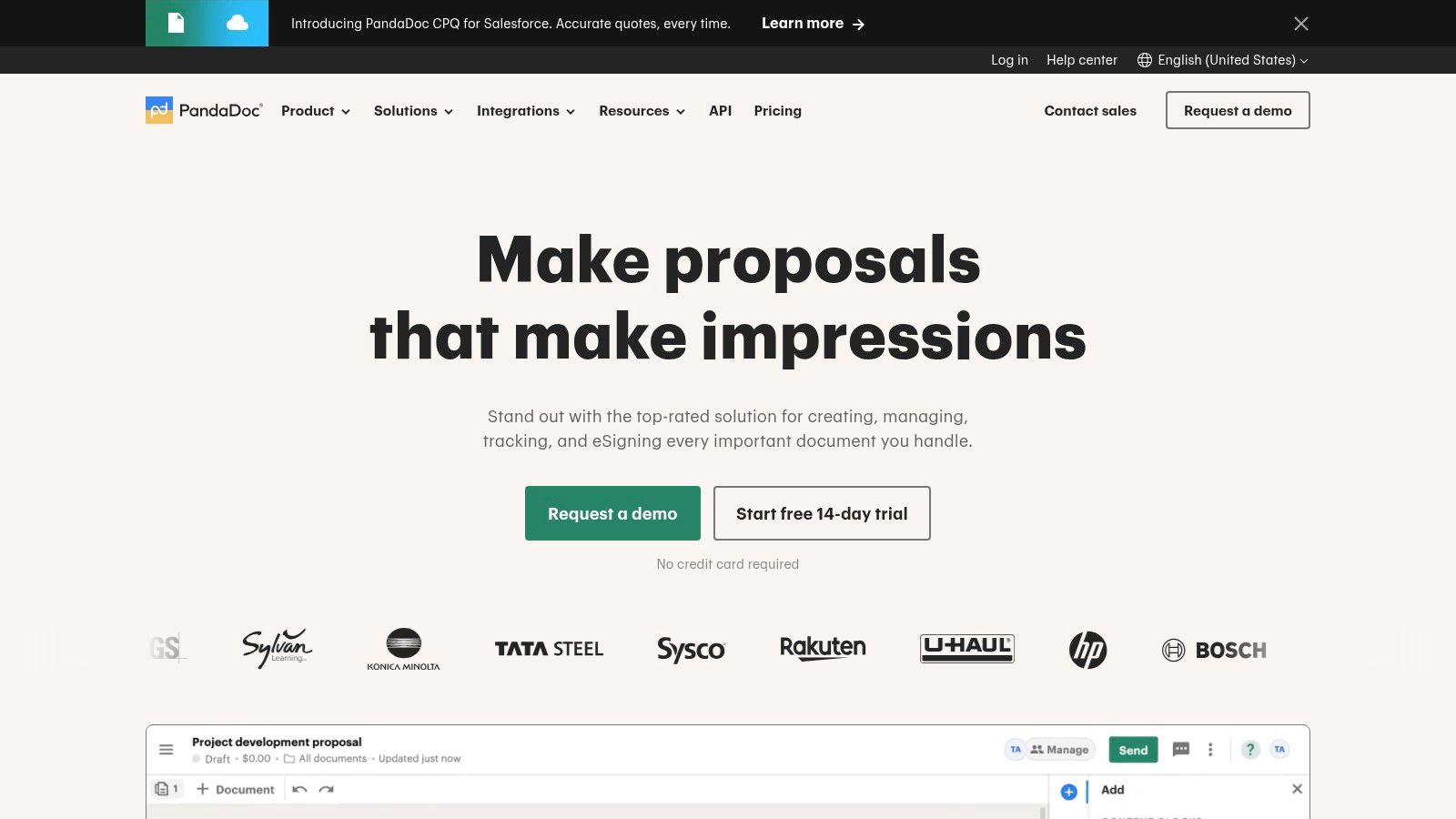
Its comprehensive feature set includes a drag-and-drop document editor with a content library, built-in electronic signatures, payment collection, document analytics, engagement tracking, and template management with role-based permissions. The platform’s CPQ (Configure, Price, Quote) functionality is particularly valuable for sales teams, enabling them to generate accurate and professional quotes quickly. Legal professionals can benefit from the robust template management and version control, ensuring consistency and accuracy across all legal documents. For healthcare providers, HIPAA compliance and secure data storage are paramount, and PandaDoc addresses these concerns with its robust security features. Security and compliance officers can use the detailed audit trails and reporting functionalities to streamline compliance processes. Learn more about PandaDoc to see how it fits in a larger automation strategy.
PandaDoc shines with its intuitive content creation using reusable content blocks, making it easy for even non-technical users to build complex documents. Its detailed analytics on document engagement, including viewing patterns and time spent on each section, provide valuable insights into recipient behavior. This is especially helpful for legal teams gauging contract comprehension or healthcare providers confirming patient understanding of treatment plans.
While PandaDoc offers a range of pricing plans, specific pricing details are available on their website. It's worth noting that some advanced customization options might require some technical knowledge. Furthermore, offline functionality is limited, and API access is restricted to higher pricing tiers. However, the robust features, intuitive interface, and focus on document security make it a strong contender for businesses looking to automate and streamline their document processes. For example, if you're comparing PandaDoc to a tool like DocuSign, you'll find PandaDoc offers more robust document creation capabilities, while DocuSign primarily excels in e-signature workflows.
Implementing PandaDoc can be relatively straightforward. Start by identifying key document workflows that could benefit from automation. Then, create templates for commonly used documents, leveraging the content library and drag-and-drop editor. Integrate PandaDoc with your existing CRM and other business systems to further streamline processes and centralize data. Finally, train your team on the platform’s features and best practices to ensure a successful implementation. The platform's website offers ample resources, including tutorials and documentation, to guide you through the setup process. Through its combination of ease of use, powerful features, and focus on security, PandaDoc earns its place on this list as a valuable tool for document automation across diverse professional fields.
4. Formstack Documents
Formstack Documents (formerly WebMerge) empowers businesses to automate the creation of a wide variety of documents, ranging from contracts and invoices to reports and more. It achieves this by seamlessly collecting data from diverse sources such as web forms, CRM systems, and spreadsheets, and dynamically populating pre-designed templates. This eliminates the tedious and error-prone process of manual data entry, significantly boosting efficiency and accuracy. This makes it particularly valuable for legal professionals dealing with high volumes of contracts, healthcare providers managing patient records, and security and compliance officers generating audit reports. For these professions, accuracy and efficiency are paramount, and Formstack Documents delivers on both fronts.
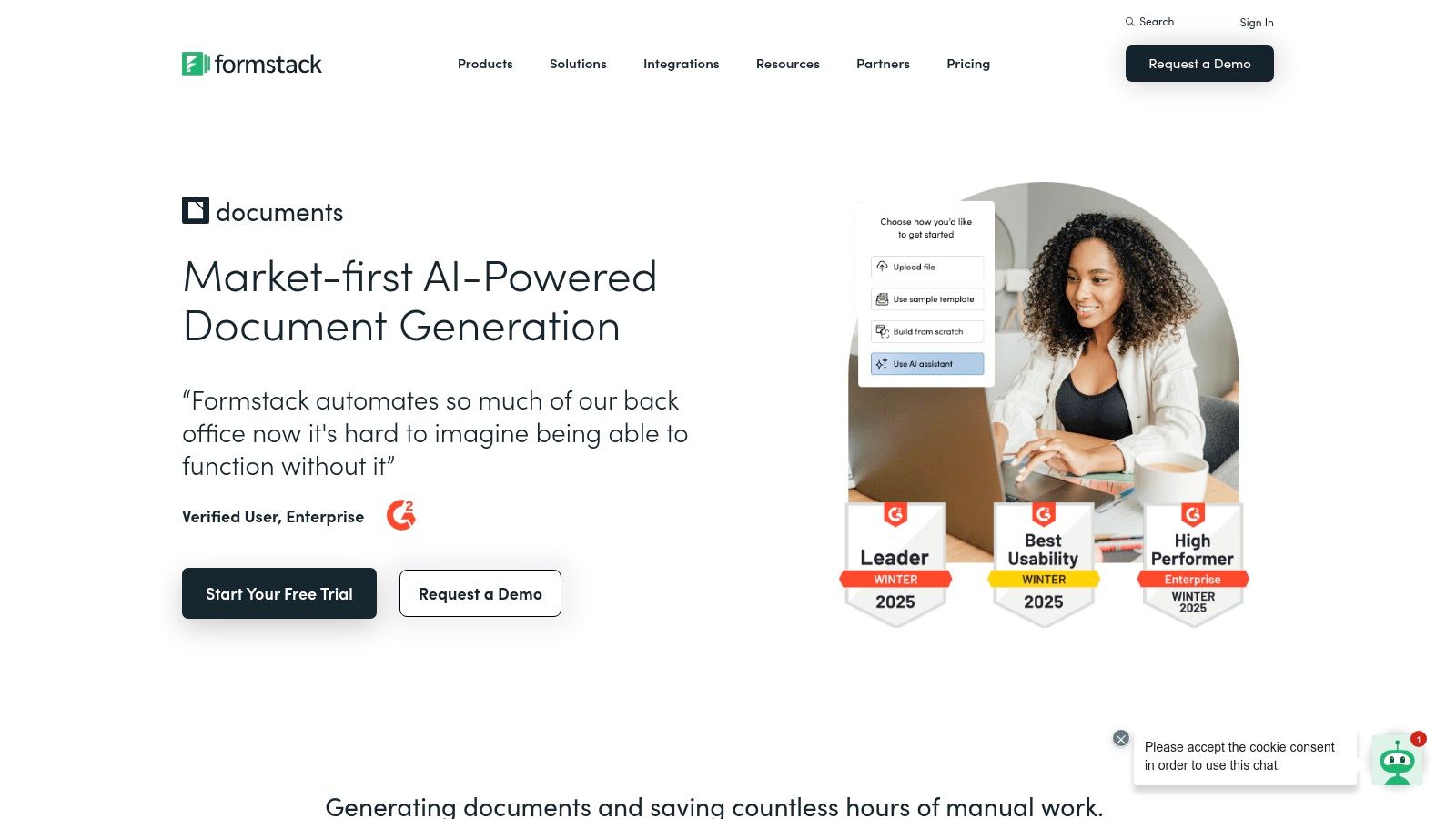
Imagine a legal team needing to generate hundreds of personalized contracts. Instead of manually filling each one, Formstack Documents can automatically populate the templates with client information pulled directly from their CRM. Similarly, healthcare providers can streamline patient intake forms, automatically populating fields with patient data and ensuring consistent, accurate records. Security and compliance officers can leverage the platform to generate comprehensive reports, pulling data from various security systems and ensuring compliance with industry regulations. Learn more about Formstack Documents and its practical applications in document management.
Formstack Documents' robust features include dynamic document generation, conditional logic, batch processing, and multiple delivery options. The conditional logic feature is particularly powerful, enabling users to create highly personalized documents. For instance, a contract could automatically include specific clauses based on the client's location or the type of service being offered. The platform also boasts integrations with over 100 apps and systems, facilitating seamless data flow and eliminating data silos. Delivery options are flexible, allowing users to send completed documents via email, save them to cloud storage, print them directly, or integrate with e-signature platforms for fully digital workflows. This broad range of functionalities justifies its inclusion in this list, offering a comprehensive solution for document automation needs.
While Formstack Documents is a powerful tool, it does have some drawbacks. The user interface, while functional, could be more intuitive, particularly for users new to document automation. Setting up complex document templates and integrations may require some technical knowledge, potentially necessitating initial training or support. Additionally, its design capabilities are somewhat limited compared to some competitors, focusing more on functionality than aesthetic customization.
Pros:
- Powerful integration capabilities with 100+ apps and systems
- Flexible document delivery options
- Advanced conditional logic for complex document requirements
- Good for high-volume document processing
Cons:
- User interface could be more intuitive
- Setup requires some technical knowledge
- Limited design capabilities compared to some competitors
Website: https://www.formstack.com/products/documents
(Pricing and technical requirements information was not provided and therefore not included.)
5. Conga Composer
Conga Composer is a robust, enterprise-grade document automation solution deeply integrated with Salesforce, making it a powerhouse for organizations heavily reliant on the CRM platform. It earns its place on this list due to its ability to handle complex document generation, particularly within sales, legal, and financial sectors, offering advanced features that go beyond simple mail merges.
Practical Applications and Use Cases:
- Legal Professionals: Conga Composer excels at generating complex legal documents like contracts, NDAs, and compliance reports directly from Salesforce data. Imagine automating the creation of a client agreement pre-populated with client details, specific clauses based on the deal type, and ready for e-signature – all triggered by a stage change in Salesforce. This streamlines workflows, minimizes manual errors, and ensures consistency across all legal documents.
- Healthcare Providers: From generating patient intake forms and consent documents to creating personalized treatment plans and discharge summaries, Conga Composer simplifies administrative tasks. By pulling patient information directly from Salesforce Health Cloud, healthcare providers can drastically reduce paperwork, freeing up valuable time for patient care.
- Security and Compliance Officers: Generating audit reports, incident reports, and policy documents often involves tedious manual processes. Conga Composer automates these tasks, pulling data from various systems, including Salesforce, ensuring data accuracy and consistency, and significantly reducing the time spent on compliance-related paperwork. Furthermore, built-in version control and audit trails enhance compliance efforts.
Features and Benefits:
- Deep Salesforce Integration: Directly merge data from Salesforce objects and records into documents, eliminating manual data entry and minimizing errors.
- Sophisticated Template Management: Utilize a user-friendly interface to create and manage templates, with version control features that ensure you're always working with the latest version.
- Complex Conditional Logic & Calculations: Create dynamic documents that adapt based on specific criteria and perform calculations within the document itself. This is especially valuable for generating quotes, proposals, and reports with variable data.
- Batch Document Generation: Generate large volumes of personalized documents with a single click, saving significant time and resources.
- Robust Reporting and Analytics: Track document generation activity, identify bottlenecks, and gain valuable insights into document usage.
Pros:
- Extremely Powerful for Salesforce-Centric Organizations: Seamless integration with Salesforce makes it an ideal choice for organizations heavily reliant on the platform.
- Enterprise-Grade Security and Compliance: Offers robust security features and compliance certifications to protect sensitive data.
- Handles Complex Document Scenarios: Can manage complex documents involving multiple data sources, calculations, and conditional logic.
- Scales Well for Large Organizations: Designed to handle high volumes of document generation and manage complex workflows.
Cons:
- Steeper Learning Curve: The advanced features and flexibility of Conga Composer can result in a steeper learning curve compared to simpler tools.
- Premium Pricing: Its enterprise-grade capabilities come with a premium price tag, which may be prohibitive for smaller businesses.
- Most Valuable for Salesforce Users: While it can integrate with other systems, its primary strength lies in its Salesforce integration, making it less advantageous for organizations not using Salesforce.
Pricing and Technical Requirements:
Conga offers tiered pricing based on features and usage. Contact Conga directly for detailed pricing information. Technical requirements primarily revolve around Salesforce compatibility and access permissions.
Implementation and Setup Tips:
- Start with a clear understanding of your document automation needs. Identify the most time-consuming and error-prone document processes.
- Invest in proper training. While Conga Composer offers a user-friendly interface, taking advantage of its advanced features requires proper training.
- Leverage Conga's support resources. Conga provides comprehensive documentation, training materials, and customer support to assist with implementation and ongoing use.
Comparison with Similar Tools: Conga Composer competes with tools like S-Docs and Formstack Documents. While these tools offer simpler interfaces and more affordable pricing, they may lack the advanced features and enterprise-grade capabilities of Conga Composer.
Website: https://conga.com/products/digital-document-transformation
6. Templafy
Templafy is a robust document automation and template management solution geared towards large enterprises, particularly those with complex branding and compliance requirements. It empowers organizations to streamline document creation, ensuring brand consistency and adherence to regulatory guidelines across all departments. Think of it as a central hub for all your company's document templates, brand assets, and approved text elements, readily accessible within the applications your employees use daily, such as Microsoft Office and Google Workspace. This makes it especially relevant for legal professionals, healthcare providers, and security and compliance officers working in large, regulated environments. These professionals often handle sensitive information and require strict adherence to predefined templates and legal language, which Templafy facilitates effectively.
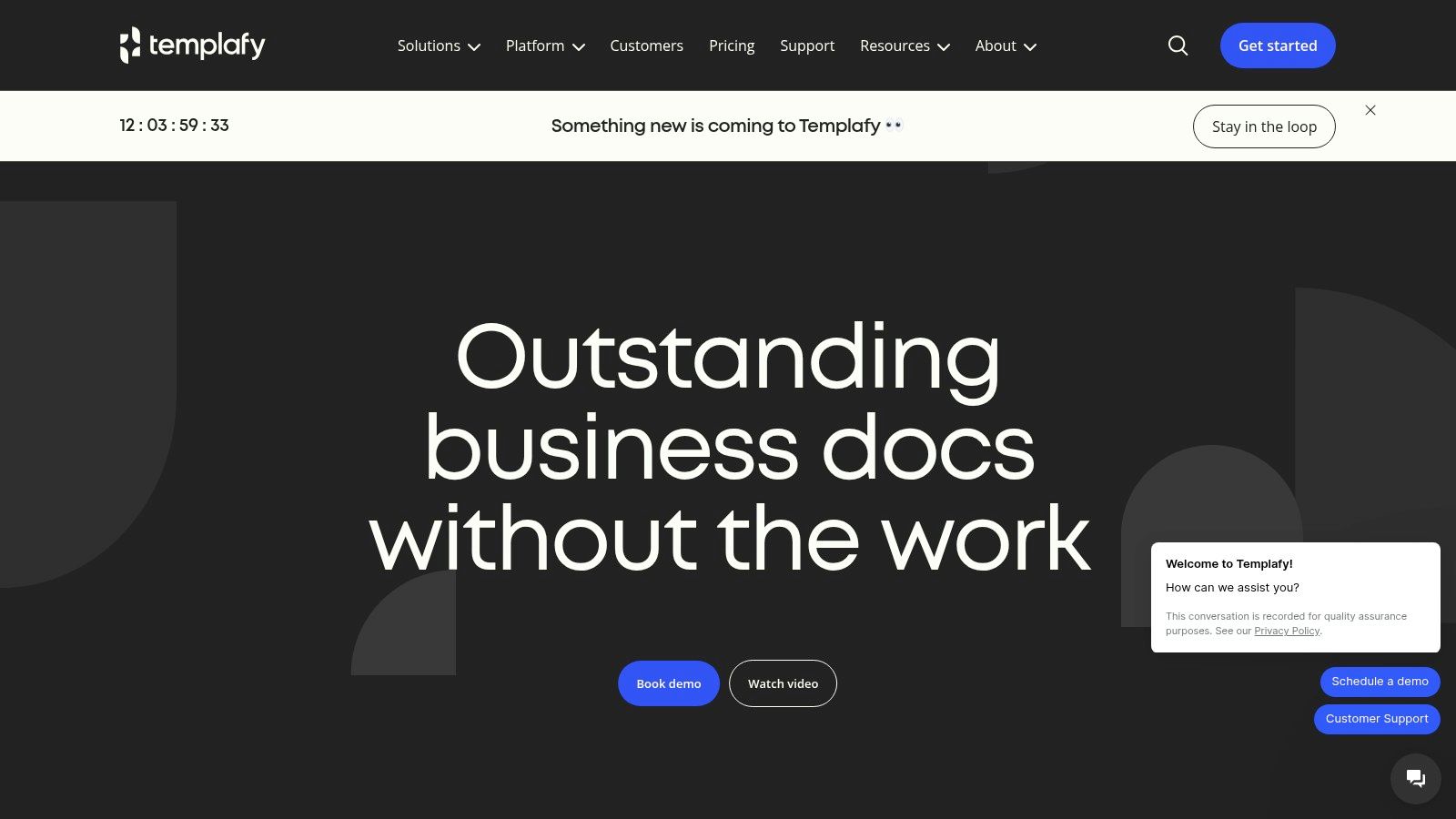
For legal professionals, Templafy ensures the consistent use of approved legal language and clauses across all documents, minimizing the risk of errors and inconsistencies. Healthcare providers benefit from standardized document templates for patient records, consent forms, and medical reports, promoting accuracy and compliance with HIPAA regulations. Similarly, security and compliance officers can leverage Templafy to enforce the use of pre-approved policy templates and security protocols, mitigating compliance risks. Templafy's dynamic template management allows administrators to update templates centrally and push changes automatically to all users, ensuring everyone works with the most current version. This eliminates the need for manual updates and drastically reduces the risk of using outdated or non-compliant documents. Furthermore, the platform’s real-time brand and compliance validation features provide immediate feedback to users, preventing deviations from established standards.
Features:
- Dynamic template management with centralized control
- Real-time brand and compliance validation
- Integration with existing productivity tools (Microsoft Office 365, Google Workspace, etc.)
- Personalized content suggestions based on user context
- Detailed usage analytics and document insights
Pros:
- Seamless integration with existing office applications minimizes disruption to workflows.
- Unparalleled brand consistency across large organizations, even across multiple departments.
- Adaptable to the specific needs of different departments, such as legal, marketing, and sales.
- Strong governance and compliance features essential for regulated industries.
Cons:
- Primarily designed for large enterprises, which might make it less suitable for smaller businesses.
- Higher price point than many other document automation tools. Contact Templafy directly for pricing details, as it's typically tailored to the specific needs and size of the organization.
- Implementation can be complex and time-consuming, often requiring dedicated IT resources.
Implementation Tips:
- Begin with a pilot program in a specific department to test and refine the implementation process.
- Thoroughly assess your current document workflows and identify key areas for improvement.
- Involve key stakeholders from different departments to ensure the solution meets their specific requirements.
- Provide comprehensive training to users to maximize adoption and effectiveness.
Comparison with similar tools: While other tools like PandaDoc and Conga Composer offer document automation capabilities, Templafy stands out with its focus on enterprise-grade brand management and compliance features. This makes it a superior choice for organizations prioritizing strict brand adherence and regulatory compliance across a large user base.
Website: https://www.templafy.com
Templafy earns its place on this list due to its powerful features for maintaining brand consistency, ensuring compliance, and streamlining document workflows in large, complex organizations. Although it comes with a higher price tag and more complex implementation, its robust features and integrations make it a worthwhile investment for enterprises prioritizing these critical aspects of document management.
7. HotDocs
HotDocs is a veteran in the document automation space, renowned for its ability to tackle highly complex document assembly, particularly within the legal field. While its roots are deeply embedded in legal, its powerful automation features extend its utility to various sectors dealing with intricate documents and processes, including healthcare, finance, and government. HotDocs excels in scenarios requiring sophisticated conditional logic, computations, and the assembly of documents from reusable components, automating tasks that would be incredibly tedious and error-prone if done manually. This makes it an ideal solution for organizations needing to generate consistent, compliant, and error-free documents on a large scale.
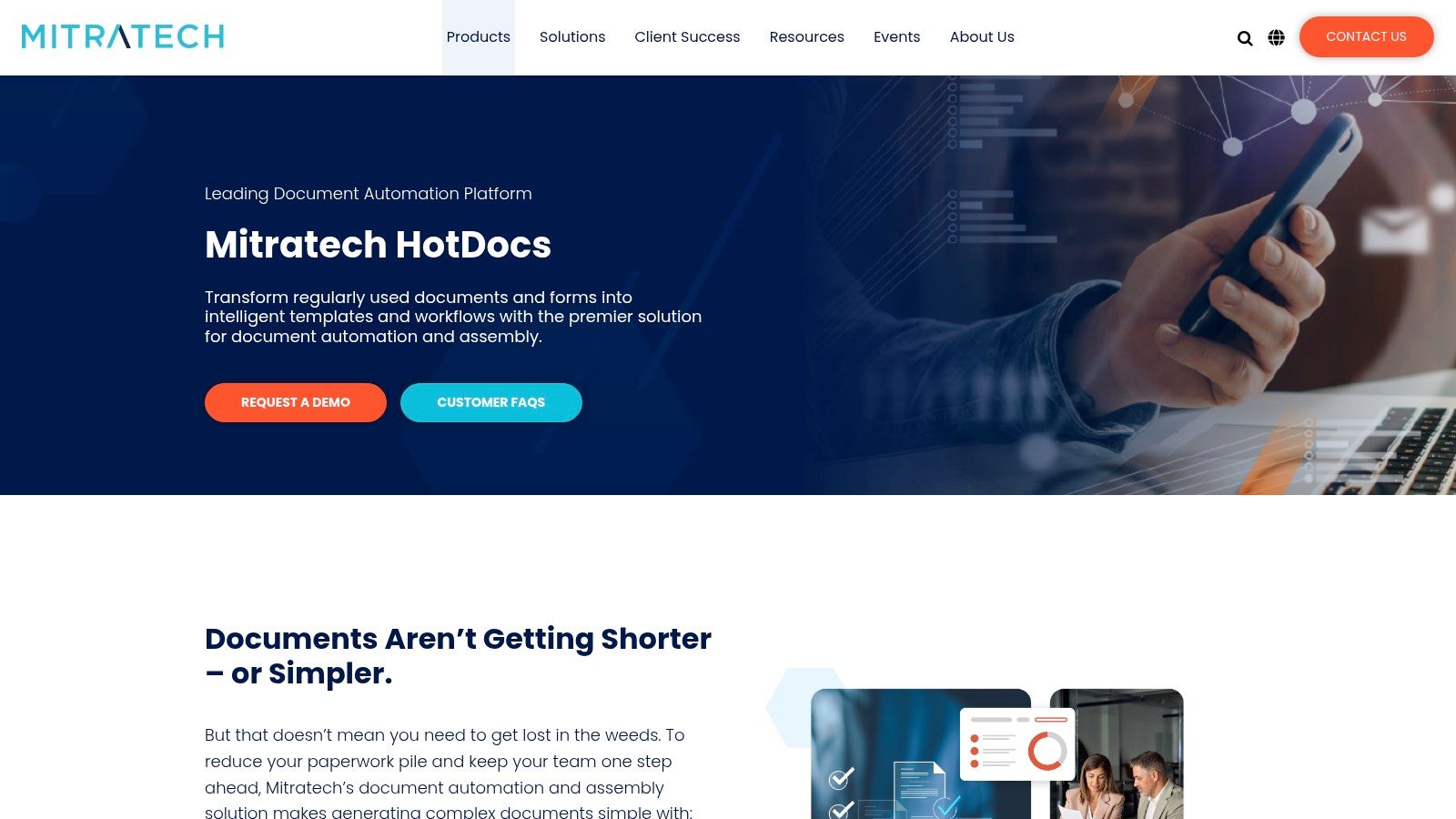
Practical Applications and Use Cases:
- Legal: Automating the creation of contracts, agreements, wills, trusts, and other legal documents with complex clauses and variables. This allows legal professionals to drastically reduce document drafting time and minimize the risk of errors.
- Healthcare: Generating personalized patient forms, consent documents, medical reports, and insurance claims with accurate data population, enhancing efficiency and patient experience.
- Security and Compliance: Creating standardized security protocols, incident reports, audit documents, and compliance checklists, ensuring consistency and adherence to regulations.
- Government: Automating the production of permits, licenses, applications, and other official documents, streamlining administrative processes and improving citizen services.
Features and Benefits:
- Advanced Template Automation: HotDocs excels at managing intricate templates with extensive conditional logic, calculations, and variable data, making it well-suited for complex document assembly scenarios.
- Component-Based Assembly: Build documents from reusable components, promoting consistency and efficiency in document creation.
- Sophisticated Logic and Computation: Handles complex calculations and conditional logic within documents, ensuring accuracy and eliminating manual calculations.
- Multi-language Support and Localization: Facilitates the creation of documents in multiple languages, catering to diverse audiences and global operations.
- Enterprise-Grade Deployment: Offers flexible deployment options, including cloud-based and on-premises solutions, to meet specific security and IT infrastructure requirements.
Pros and Cons:
Pros:
- Handles Complex Scenarios: The platform is designed to handle the most intricate document automation needs, which is crucial for compliance-heavy industries.
- Mature and Robust: Decades of development have resulted in a stable and reliable platform.
- Flexible Deployment: Offers both cloud and on-premises options, providing flexibility for organizations with varying security needs.
Cons:
- Steeper Learning Curve: The platform's advanced capabilities contribute to a steeper learning curve compared to simpler solutions.
- Dated Interface: The user interface may feel less intuitive than some newer, more modern document automation tools.
- Implementation Complexity: Setting up and implementing HotDocs often requires the assistance of specialized consultants, which can add to the initial cost.
Pricing and Technical Requirements:
HotDocs offers tiered pricing based on features and deployment options. Contact their sales team for specific pricing details. Technical requirements vary depending on the deployment method (cloud or on-premises).
Comparison with Similar Tools:
While tools like Kissflow and PandaDoc offer user-friendly interfaces and simpler setup, they might not possess the same depth of functionality for highly complex documents as HotDocs. HotDocs is a more powerful, albeit more complex, solution than many of its competitors.
Implementation and Setup Tips:
- Engage with Consultants: Consider engaging HotDocs certified consultants for initial setup, template creation, and training.
- Plan Your Templates Carefully: Thorough planning of your document templates is crucial for maximizing the benefits of HotDocs' automation capabilities.
- Invest in Training: Adequate training for users is essential to ensure they can effectively utilize the platform's features.
Website: https://www.hotdocs.com
HotDocs earns its place on this list due to its unparalleled ability to automate the creation of highly complex documents. While it might require a greater initial investment in terms of training and implementation, its robust features and proven track record make it a compelling choice for organizations with demanding document automation requirements, particularly in heavily regulated industries.
8. Documate
Documate (formerly Lawyaw) stands out as a user-friendly document automation platform specifically designed to streamline document creation workflows, primarily within the legal industry but increasingly branching out to other sectors. It empowers users, even those without programming experience, to transform static documents into dynamic, automated templates. This functionality is particularly beneficial for legal professionals, healthcare providers, and security/compliance officers dealing with large volumes of paperwork, allowing them to generate accurate and consistent documents rapidly. This efficiency boost allows these professionals to focus on more strategic tasks rather than tedious administrative work. Think about the time saved automating intake forms, generating complex legal documents, or creating standardized compliance reports. Documate achieves this through a no-code builder, making it accessible to a wider range of users.
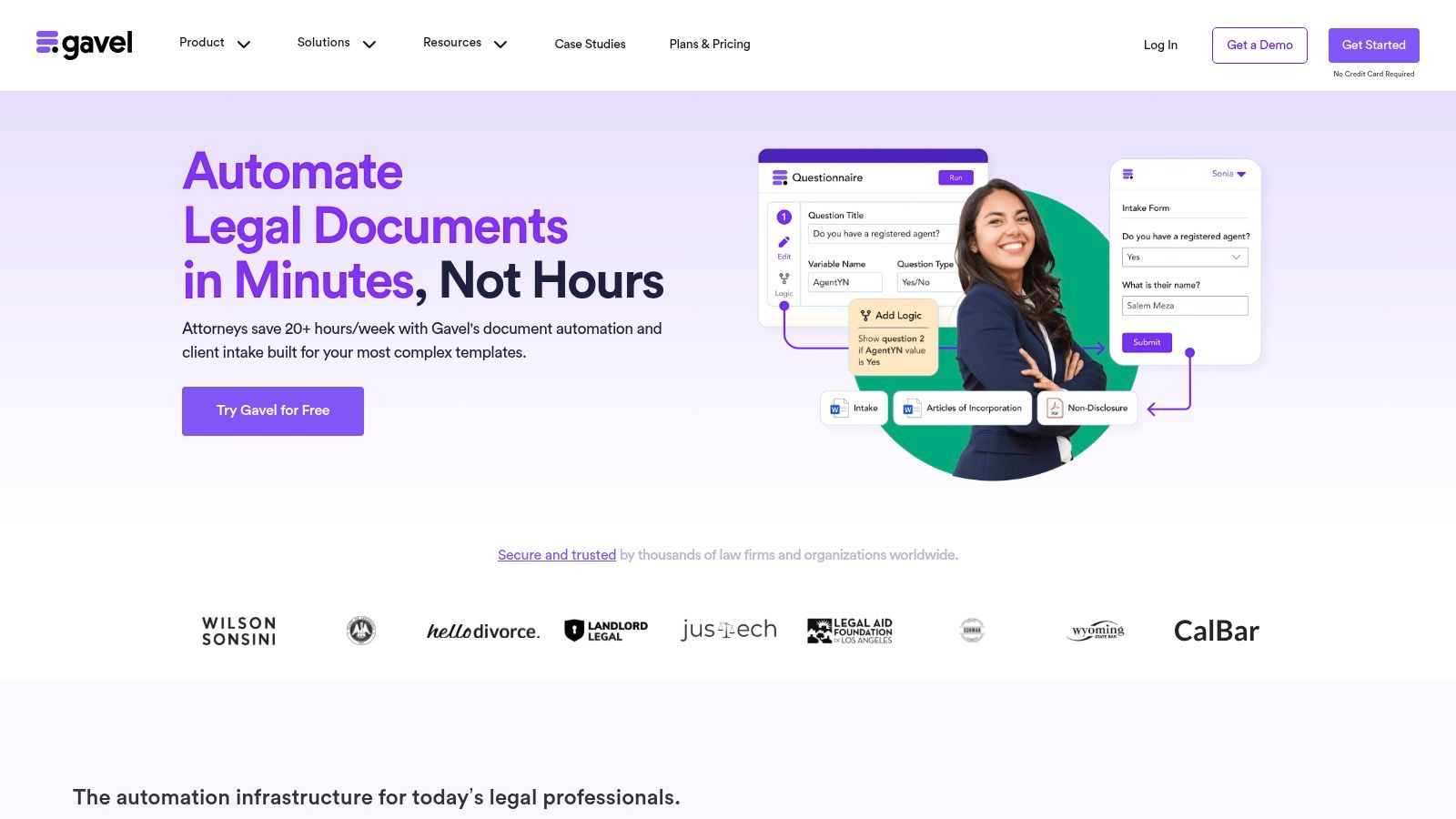
A key feature of Documate is its ability to create web-based client intake forms that directly populate document templates. This removes the need for manual data entry, reducing errors and speeding up the document creation process. Imagine a legal professional using Documate to generate a complex contract. The client’s information, entered via a web form, automatically populates the contract, minimizing the risk of typos and ensuring consistency. Similarly, a healthcare provider can use Documate to automate patient intake forms, significantly streamlining administrative processes. For security and compliance officers, automating the generation of standard reports can ensure adherence to regulatory requirements and save valuable time. Documate's strength lies in its focus on legal use cases, evident in features such as court form automation with jurisdiction-specific templates. It also incorporates conditional logic and calculations within documents, allowing for complex and customized outputs based on user input. Furthermore, integration with electronic signature platforms further streamlines the workflow, allowing for seamless document completion and execution. Learn more about Documate to see how it can benefit your specific needs.
While pricing information isn't readily available, Documate offers a tiered subscription model suitable for small to mid-sized organizations. Technical requirements are minimal, as the platform is web-based and designed for ease of use. Compared to complex enterprise solutions like Conga Composer or PandaDoc, Documate's streamlined approach makes implementation quick and relatively painless. However, this focus on simplicity can be a limiting factor for organizations with complex enterprise-level document automation needs. Integration options are also more limited compared to some competitors.
Pros:
- User-friendly interface requiring minimal technical knowledge
- Specifically designed for legal use cases with relevant features like court form automation
- Quick implementation compared to enterprise solutions
- Good value for small to mid-sized organizations
Cons:
- Less suited for complex enterprise document needs
- More limited integration options than some competitors
- Primary focus on legal sector may limit some general business features
Documate earns its place on this list by providing a powerful yet accessible document automation solution tailored to the specific needs of legal professionals and others dealing with complex documentation. Its user-friendly interface, coupled with features like web-based forms and electronic signature integration, significantly reduces the time and effort associated with document creation, freeing up valuable time for more strategic tasks. You can explore Documate further on their website: https://www.documate.org
9. Nintex Document Generation
Nintex Document Generation (formerly Drawloop) distinguishes itself by offering robust document automation within a larger business process automation ecosystem. This makes it particularly attractive to organizations looking to streamline multiple processes, not just document creation. Imagine automating the entire lifecycle of a contract, from initial creation and approvals to final signature and archiving – all within a single platform. This is the strength of Nintex. It empowers users to automatically generate a wide variety of documents, such as contracts, invoices, reports, and policies, by pulling data from integrated systems, minimizing manual data entry and reducing the risk of errors. This is particularly relevant for legal professionals needing to generate complex legal documents quickly and accurately, healthcare providers dealing with extensive patient paperwork, and security and compliance officers ensuring adherence to regulatory standards through consistent documentation.
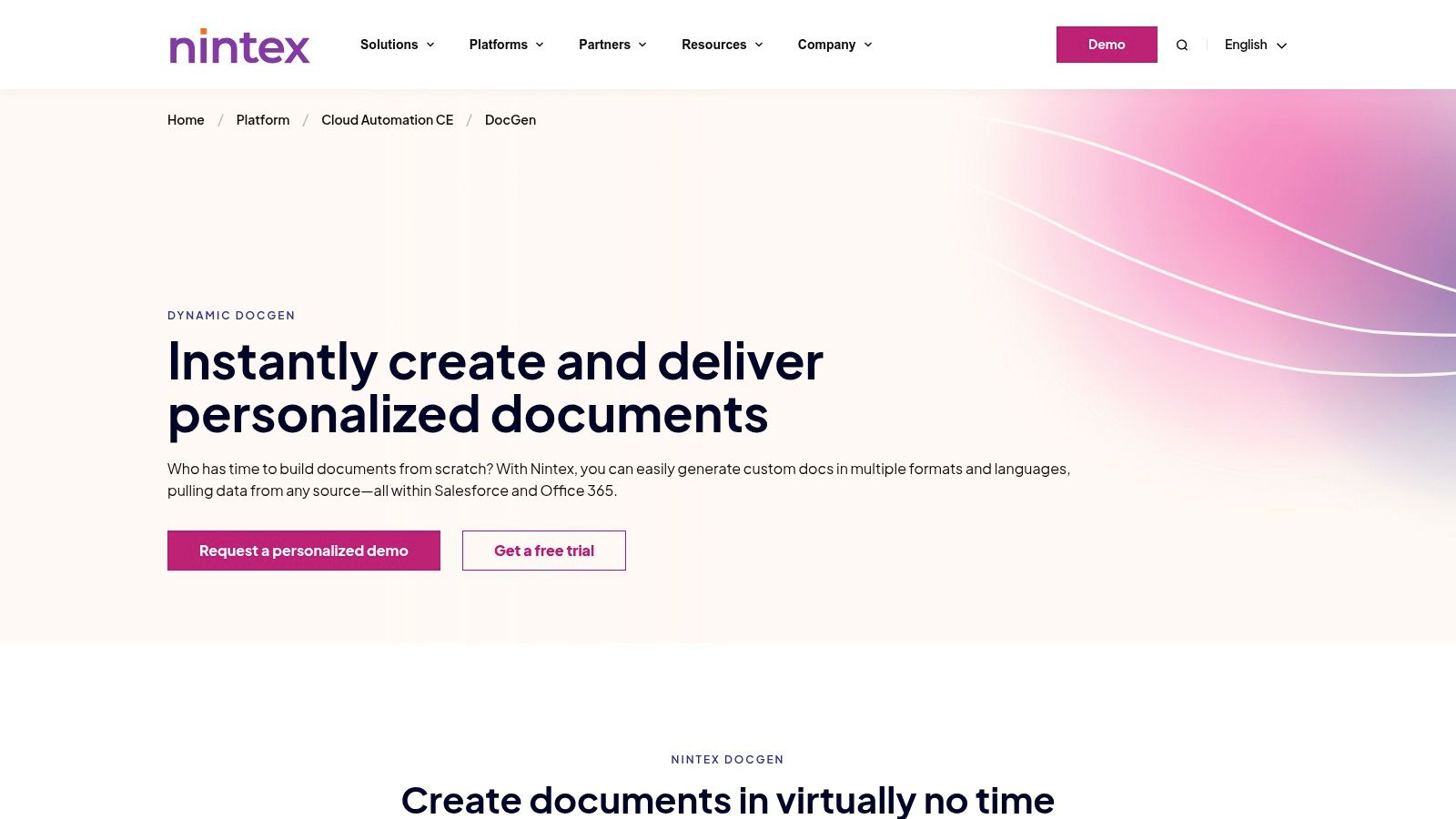
For legal professionals, Nintex can automate the creation of complex legal documents, such as NDAs, contracts, and court filings, by pre-filling information from existing databases and systems. This ensures consistency, reduces errors, and frees up valuable time for higher-value tasks. Healthcare providers can leverage Nintex to automate the generation of patient intake forms, discharge summaries, and medical reports, ensuring accuracy and improving patient care. Security and compliance officers can benefit by automating the creation of audit reports, policy documents, and incident reports, ensuring consistent formatting and adherence to regulatory requirements.
Key features like sophisticated template management, digital signature integration, and support for complex documents with tables, charts, and images make it a versatile tool. Specifically, the ability to handle complex documents is a critical advantage, particularly for legal and compliance use cases where precise formatting and detailed information are essential. Integration with Salesforce and SharePoint further extends its functionality, allowing organizations to leverage existing data within their document automation workflows. For example, a sales team using Salesforce can automatically generate personalized proposals and contracts directly within their CRM, eliminating manual data entry and accelerating the sales cycle.
Pros:
- Comprehensive Platform: Being part of the Nintex Process Platform offers the advantage of integrating document automation seamlessly with broader workflows, forms, and even robotic process automation.
- Strong Microsoft Ecosystem Integration: Excellent synergy with Microsoft tools makes it an ideal choice for organizations heavily reliant on the Microsoft ecosystem.
- Enterprise-Grade Security and Governance: Robust security features are crucial for sensitive documents and compliance requirements.
Cons:
- Higher Cost: The comprehensive nature of the platform can lead to higher costs, especially if you only need basic document generation features.
- Complexity: Implementing the full Nintex platform can be complex and may require specialized expertise. Simpler solutions might be more suitable for organizations with limited IT resources.
- Overkill for Simple Use Cases: For very basic document automation needs, Nintex might be more powerful than necessary.
Pricing: Nintex doesn't publicly list pricing for its products. Contacting their sales team for a customized quote is necessary.
Technical Requirements: Specific technical requirements vary based on the chosen components of the Nintex platform and integration needs. Consultation with Nintex is recommended to determine the specific requirements for your organization.
Implementation Tips:
- Start with a Clear Scope: Define your specific document automation needs and objectives before implementation.
- Leverage Existing Integrations: Maximize the value of Nintex by utilizing its integrations with systems you already use, such as Salesforce or SharePoint.
- Consider Phased Rollout: Implementing the full platform can be complex. Consider a phased approach, starting with core document automation functionalities and gradually expanding to other areas.
Comparison with Similar Tools: While tools like PandaDoc or DocuSign primarily focus on e-signatures and simpler document workflows, Nintex differentiates itself by offering a comprehensive platform that encompasses the entire document lifecycle within a broader automation ecosystem. This makes Nintex a more suitable choice for organizations looking to automate complex document-driven processes.
Website: https://www.nintex.com/process-automation/document-generation/
Nintex Document Generation earns its place on this list by offering a robust and integrated approach to document automation. While it may not be the ideal solution for every organization, its comprehensive features and integration capabilities make it a compelling option for those seeking to streamline complex document-driven processes within a larger automation strategy.
10. Juro
Juro is a contract automation platform specifically designed to streamline the entire contract lifecycle, from creation and approval to management and signing, all within a single unified workspace. Unlike more generic document automation tools, Juro treats contracts as structured data, not just documents. This data-first approach unlocks powerful features like advanced search, analytics, and lifecycle management, making it particularly well-suited for fast-moving businesses that handle a high volume of contracts. Its focus on user-friendliness and browser-native functionality makes it a popular choice for legal teams, sales operations, and other business units involved in contract management.
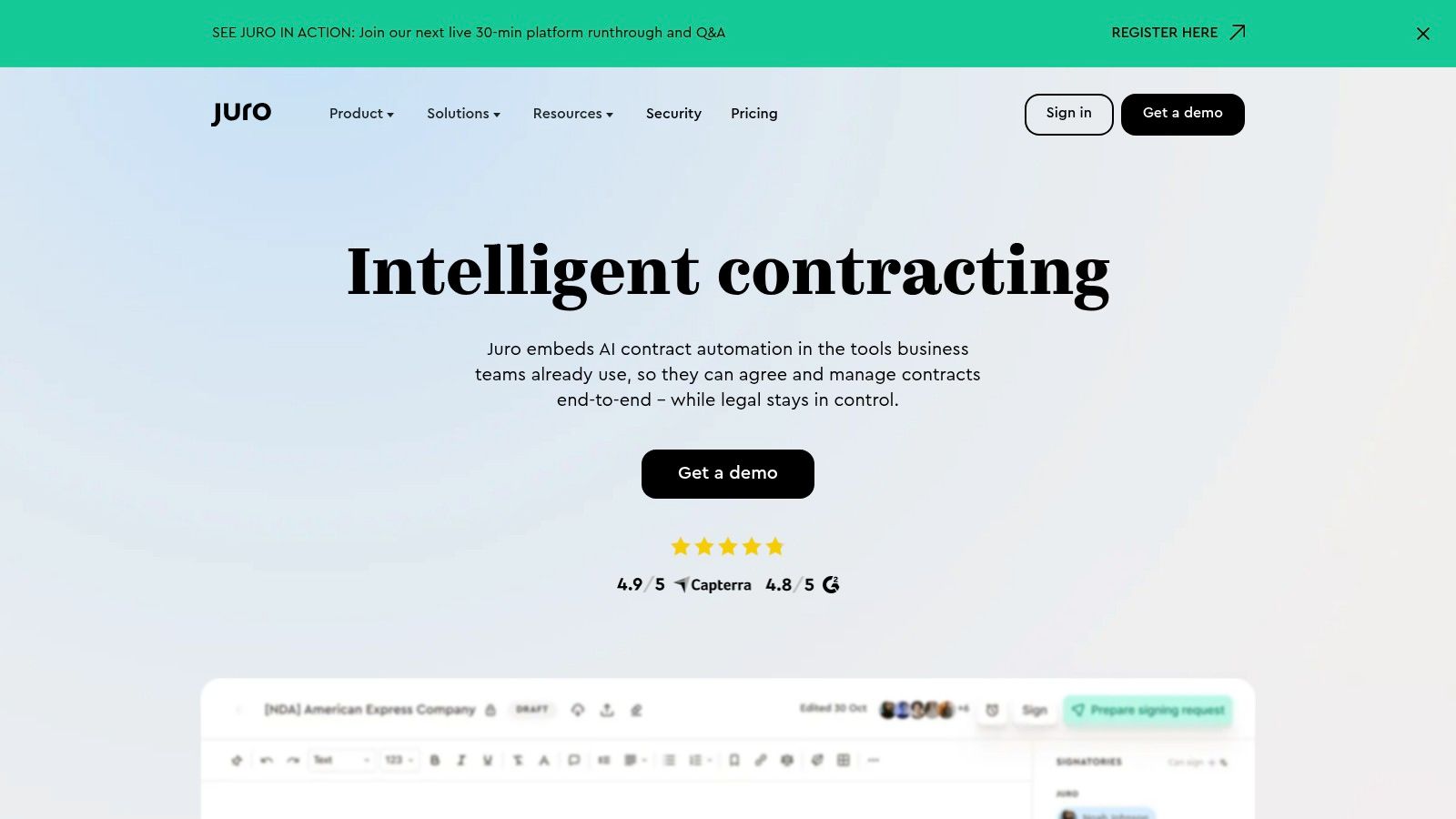
For legal professionals, Juro offers a centralized platform to manage all contracts, ensuring version control, compliance, and easy access to key contract data. Healthcare providers can benefit from Juro's streamlined contract processes for vendor agreements, patient consent forms, and employment contracts. Security and compliance officers will appreciate the robust audit trails and secure e-signature capabilities, ensuring data integrity and compliance with industry regulations.
Juro shines in use cases like:
- Sales contracts: Automate sales agreements with dynamic templates and integrated e-signatures, accelerating the sales cycle.
- NDA’s: Standardize and quickly generate non-disclosure agreements, ensuring consistent language and fast execution.
- Employment contracts: Simplify onboarding with automated employment contracts and offer letters, reducing administrative overhead.
Features:
- Contract creation with dynamic, data-driven templates: Create reusable templates with dynamic fields, minimizing manual data entry and reducing errors.
- Collaborative editing and approval workflows: Streamline internal approvals with built-in workflows and notifications.
- Native eSignature capabilities: Securely sign contracts electronically without the need for external e-signature tools.
- Contract repository with AI-powered search: Centrally store and manage all contracts with an AI-powered search function for quick access to specific clauses or agreements.
- Contract analytics and deadline tracking: Gain valuable insights into contract performance and manage deadlines proactively.
Pros:
- User-friendly interface with modern design: Intuitive interface simplifies contract management, even for non-technical users.
- Unique data-first approach to contracts enables better analytics: Leverage contract data for valuable business insights and reporting.
- No need for separate eSignature tools: Integrated e-signatures simplify the signing process and reduce costs.
- Self-service implementation possible for many use cases: Easily implement and configure Juro without extensive IT support.
Cons:
- More focused on contracts rather than general document automation: Less suitable for automating a wider range of document types beyond contracts.
- Less suitable for complex multi-system document workflows: May not be the best fit for organizations requiring deep integrations with multiple legacy systems.
- Limited customization for highly specialized industries: While suitable for many industries, highly specialized fields might require more customization options.
Pricing: Juro offers tailored pricing based on specific business needs. Contact their sales team for a quote.
Technical Requirements: Juro is a cloud-based platform accessible through any modern web browser, minimizing technical requirements and simplifying implementation.
Implementation Tips: Begin by identifying key contract types and creating corresponding templates. Integrate Juro with existing CRM or other business systems for seamless data flow. Train users on the platform to maximize adoption and efficiency.
Comparison with similar tools: While tools like PandaDoc and DocuSign offer broader document automation features, Juro's specialized focus on contracts, coupled with its data-driven approach and user-friendly interface, makes it a strong contender, particularly for organizations prioritizing contract lifecycle management.
Website: https://juro.com
Juro earns its place on this list by offering a powerful yet user-friendly solution specifically designed for modern contract management. Its data-centric approach, combined with seamless e-signatures and robust analytics, provides significant value for organizations seeking to streamline their contract processes and gain greater control over their contractual agreements.
Top 10 Document Automation Tools Comparison
| Solution | Core Features ✨ | Experience ★ | Value 💰 | Audience 👥 | Differentiator |
|---|---|---|---|---|---|
| 🏆 Whisperit | AI dictation, transcription, legal research, secure & compliant | Fast, efficient, advanced AI | Cuts doc time; significant cost savings | Legal, healthcare, professionals | Revolutionary speed & top-notch security |
| DocuSign | eSignature, template & workflow automation, tracking | Intuitive, mobile-friendly | Extensive integrations | All business sizes | Widely adopted with robust security |
| PandaDoc | Drag-drop editor, eSignatures, CPQ, analytics | User-friendly, sales-focused | Accelerates proposals & contracts | Sales teams, business units | Strong analytics & reusable content blocks |
| Formstack Documents | Dynamic generation, conditional logic, multi-delivery | Efficient for high-volume docs | Flexible integration & automation | Healthcare, legal, finance | Powerful data merging capabilities |
| Conga Composer | Salesforce integration, template management, conditional logic | Enterprise-grade; complex workflows | Scalable for large orgs | Salesforce-centric enterprises | Deep Salesforce connectivity |
| Templafy | Template management, compliance validation, Office integration | Seamless, centralized control | Enhances brand consistency | Large enterprises | Centralized governance and brand asset control |
| HotDocs | Advanced legal document assembly, conditional logic | Mature, robust, time-tested | Manages intricate automation | Legal, financial, government | Established legacy in legal document automation |
| Documate | No-code automation, web-based forms, eSign integration | Simple, quick to deploy | Cost-effective legal automation | Small/mid-sized law firms | Legal-focused with ease-of-use |
| Nintex Document Generation | Automated doc generation, workflow integration, advanced templates | Part of a comprehensive automation suite | Complements full process automation | Enterprises with broad automation needs | Integrated process and document automation |
| Juro | Contract creation, collaborative editing, native eSignature | Modern, intuitive, data-driven | Streamlines contract lifecycle | Tech, fintech, marketplaces | Unique data-first approach to contract management |
Choosing the Right Document Automation Software for Your Needs
From streamlining contract creation for legal professionals to simplifying patient onboarding in healthcare and ensuring robust compliance documentation, the right document automation software can revolutionize your workflows. This listicle has explored ten powerful tools – Whisperit, DocuSign, PandaDoc, Formstack Documents, Conga Composer, Templafy, HotDocs, Documate, Nintex Document Generation, and Juro – each offering unique features and capabilities. The most important takeaway is that there's no one-size-fits-all solution.
When selecting a tool, prioritize your specific needs. Consider the complexity of your documents, the volume you handle, and the level of integration required with your existing systems. Security is paramount, especially for sensitive information, so robust security features are essential. Ease of use is also a critical factor, especially for teams with varying technical skills. If your organization is heavily invested in software development, efficient documentation practices are key. For a deeper dive into modern documentation practices, especially for software projects, explore the benefits of treating your documentation like code. This approach, known as Documentation as Code can greatly enhance collaboration and consistency within your development team. Source: Documentation as Code: A Practical Guide to Modern Software Development from DocuWriter.ai.
By carefully evaluating your needs and exploring the options outlined here, you can empower your organization to move beyond tedious manual processes and embrace the efficiency and accuracy of automated document generation. The future of document management is here, and the right tool can unlock unprecedented levels of productivity in 2025 and beyond.
Ready to experience the power of AI-driven document automation? Streamline your workflows and enhance productivity with Whisperit, a cutting-edge document automation platform designed to create, manage, and analyze documents with unparalleled efficiency. Explore Whisperit today and discover a smarter way to handle your document-related tasks.